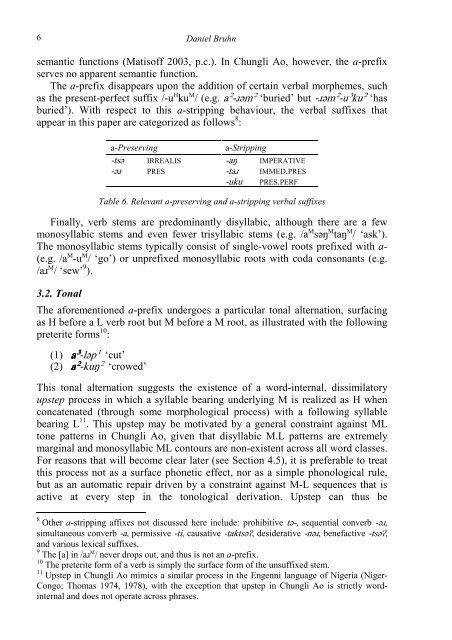A TONAL TAXONOMY OF CHUNGLI AO VERBS Daniel Bruhn ...
A TONAL TAXONOMY OF CHUNGLI AO VERBS Daniel Bruhn ...
A TONAL TAXONOMY OF CHUNGLI AO VERBS Daniel Bruhn ...
Create successful ePaper yourself
Turn your PDF publications into a flip-book with our unique Google optimized e-Paper software.
6<br />
<strong>Daniel</strong> <strong>Bruhn</strong><br />
semantic functions (Matisoff 2003, p.c.). In Chungli Ao, however, the a-prefix<br />
serves no apparent semantic function.<br />
The a-prefix disappears upon the addition of certain verbal morphemes, such<br />
as the present-perfect suffix /-u H ku M / (e.g. a²-ɹəm² ‘buried’ but -ɹəm²-u³ku² ‘has<br />
buried’). With respect to this a-stripping behaviour, the verbal suffixes that<br />
appear in this paper are categorized as follows 8 :<br />
a-Preserving a-Stripping<br />
-tsə IRREALIS -aŋ IMPERATIVE<br />
-əɹ PRES -taɹ IMMED.PRES<br />
-uku PRES.PERF<br />
Table 6. Relevant a-preserving and a-stripping verbal suffixes<br />
Finally, verb stems are predominantly disyllabic, although there are a few<br />
monosyllabic stems and even fewer trisyllabic stems (e.g. /a M səŋ M taŋ M / ‘ask’).<br />
The monosyllabic stems typically consist of single-vowel roots prefixed with a-<br />
(e.g. /a M -u M / ‘go’) or unprefixed monosyllabic roots with coda consonants (e.g.<br />
/aɹ M / ‘sew’ 9 ).<br />
3.2. Tonal<br />
The aforementioned a-prefix undergoes a particular tonal alternation, surfacing<br />
as H before a L verb root but M before a M root, as illustrated with the following<br />
preterite forms 10 :<br />
(1) a³-ləp¹ a³ a³ a³ ‘cut’<br />
(2) a²-kuŋ² a² a² a² ‘crowed’<br />
This tonal alternation suggests the existence of a word-internal, dissimilatory<br />
upstep process in which a syllable bearing underlying M is realized as H when<br />
concatenated (through some morphological process) with a following syllable<br />
bearing L 11 . This upstep may be motivated by a general constraint against ML<br />
tone patterns in Chungli Ao, given that disyllabic M.L patterns are extremely<br />
marginal and monosyllabic ML contours are non-existent across all word classes.<br />
For reasons that will become clear later (see Section 4.5), it is preferable to treat<br />
this process not as a surface phonetic effect, nor as a simple phonological rule,<br />
but as an automatic repair driven by a constraint against M-L sequences that is<br />
active at every step in the tonological derivation. Upstep can thus be<br />
8 Other a-stripping affixes not discussed here include: prohibitive tə-, sequential converb -əɹ,<br />
simultaneous converb -a, permissive -ti, causative -taktsəʔ, desiderative -nəɹ, benefactive -tsəʔ,<br />
and various lexical suffixes.<br />
9 The [a] in /aɹ M / never drops out, and thus is not an a-prefix.<br />
10 The preterite form of a verb is simply the surface form of the unsuffixed stem.<br />
11 Upstep in Chungli Ao mimics a similar process in the Engenni language of Nigeria (Niger-<br />
Congo; Thomas 1974, 1978), with the exception that upstep in Chungli Ao is strictly wordinternal<br />
and does not operate across phrases.

















